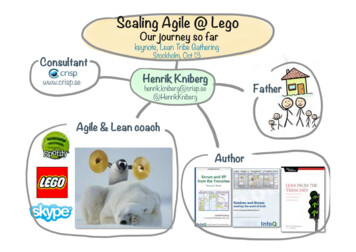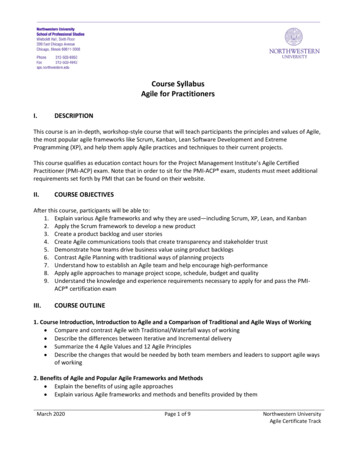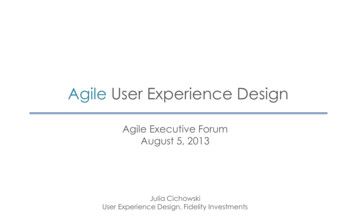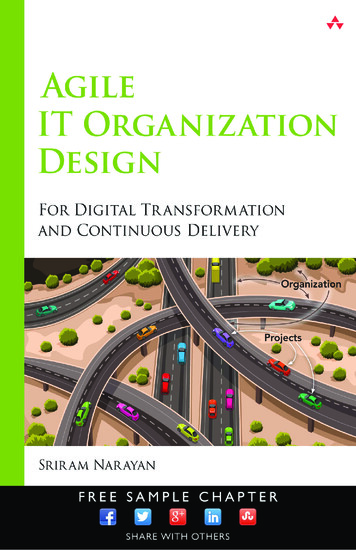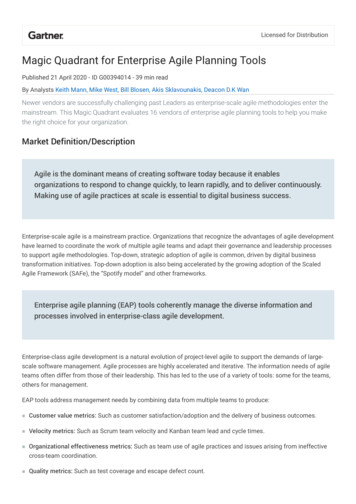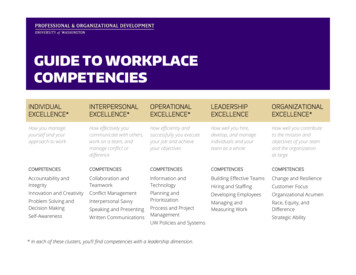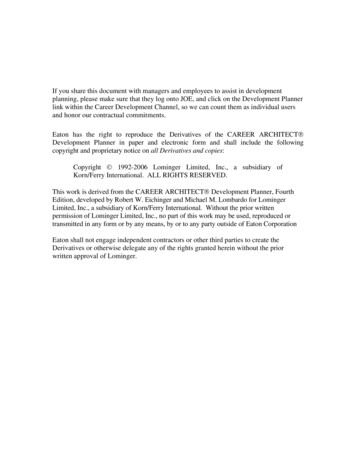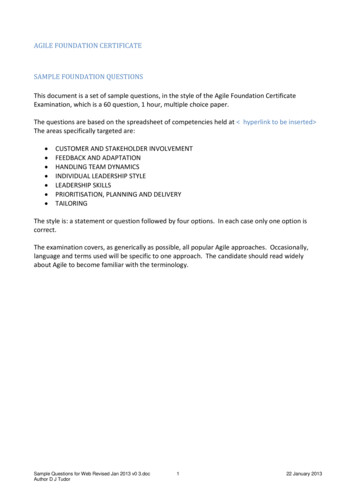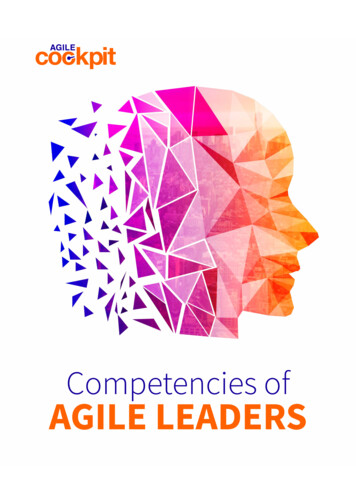
Transcription
Competencies ofAGILE LEADERS
INDEXINTRODUCTIONOVERVIEW OF THE COMPETENCIESPERSONAL AGILITYPEOPLE AGILITYSTAKEHOLDER/CUSTOMER AGILITYCHANGE AGILITYRESULTS AGILITYMENTAL AGILITYINNOVATION AGILITYSYSTEMS AGILITYABOUT US345678910111213
INTRODUCTIONAgile Leaders have an inclusive and a collaborative mindset. Theyunderstand the needs of their employees and colleagues to effectivelyperform their responsibilities and acknowledge the individuality ofpeople. Agile Leaders appreciate constant change and use it as anopportunity to learn and grow. The basic difference that sets apart anAgile Leader from a traditional leader is that an Agile Leader does not,in any sense, control or manage their employees. They have an ‘Agile’mindset. Agile Leaders must have a specific set of competencies inorder to stand out in their role and be a leader par excellence.Competency Framework basically defines the behaviors for successfuland excellent performance in a role. Each competency is defined and aset of ‘behavioral indicators’ are identified in order to understand whateach competency actually means and what it is that one needs to do todevelop or improve on a given competency.What is Agile Leadership CompetencyFramework?Our Agile Leadership Competency Framework strives to articulate theexpected behavioral patterns that are required to be a successful Agileleader. It comprises of specific definitions and the exact behavioralindicators which provides a standard to identify, develop and improvethe Agile Leaders’ competencies for successful performance and toholistically develop their Agility.Request your assessment3
OVERVIEW OF THECOMPETENCIESPersonal AgilityChange AgilityThe ability to be self-aware andhave a realistic view of one’s ownstrengths, weaknesses and areasof improvement.The ability to identify and seizeopportunities in a consistentlychanging environment andenabling teams to contribute tochange.People AgilityThe ability to understand andrelate to other people andcollaboratively work with them indynamic situations to harness andmultiply collective performance.Stakeholder AgilityThe ability to leverage datato understand and validatestakeholder’s/customer’sassumptions and hypotheses andensure complete stakeholder/customer satisfaction.Results AgilityThe ability to deliver valuableresults in short iterations byinspiring teams and enabling theorganization to execute long-rangestrategic plans.4Mental AgilityThe ability to think critically todeal with complex problems andexpand possibilities.Innovation AgilityThe ability to focus on untestedhypotheses and validate theirrelevance through continuousexperimentation to trigger creativediscovery and innovation.Systems AgilityThe ability to embrace, encourageand follow systems thinking, agilevalues, principles and practices.
PERSONAL AGILITYDefinition:The Agile Leader constantly works towards reflecting on, recognizingand self-challenging personal assumptions and perceptions. The AgileLeader gives people the power of vision instead of instructions, evenwhile working in less known or untested business environments. TheAgile Leader creates a culture in their organization where there istime and space for reflection, and where it is “safe to fail”. The AgileLeader establishes this by using short iterations, and thus creates anenvironment in which learning from experiences and early validation ofbusiness needs, solutions and ways of working is established.Behavioral Indicators: Reflects upon, recognizes and self-challenges one’s personalassumptions and perceptions and how it impacts the employeesand teams. Empowers the teams towards the vision rather than givinginstructions while working towards untested hypotheses. Creates a “safe to fail” environment by looking for learnings andfuture improvements. Reflects on improving iterative discovery while learning throughexperiences and ensuring early validation of business needs,solutions, and ways of working.5
PEOPLE AGILITYDefinition:The Agile Leader has a people-oriented approach which focuses ondeveloping the teams and employees by helping and empoweringthem to enhance their personal talents. The Agile Leader fosters multidisciplinarity by striving towards T-Shaped (Specialist in one area, butcollaborates to other fields also), Pi-Shaped (broad knowledge of allareas, but expert in 2 areas) and M-Shaped (high-performance crossfunctional) personal profiles. The Agile Leader encourages and coachespeople to take up a team-oriented mindset in which talents are valuedand handicaps are accepted.Behavioral Indicators: Establishes high performing teams which are cross-functional andcapable of end-to-end delivery. Encourages team focus so that there are dedicated team membersto accomplish the goals. Empowers people to enhance their personal abilities by strivingtowards T-shaped, Pi-shaped and M-shaped personal profiles. Shapes the Agile environment by focusing on removingorganizational impediments like, interdependencies betweenteams, functional silos, unrealistic deadlines, over or underallocation of teams’ capacities. Coaches team members to take up a team-oriented mindset.6
STAKEHOLDER/CUSTOMER AGILITYDefinition:The Agile Leader is constantly in search of iterative validation of earlybusiness results and discovery of emerging value opportunities. TheAgile Leader is able to critically reflect upon, evaluate assumptions andhypotheses of stakeholders/customers while leveraging and validatingwith data to understand and predict stakeholder/customer needs. TheAgile Leader ensures value flow to the stakeholder/customer in shortiterations thereby decreasing the time to market and time to learn.Behavioral Indicators: Ensures iterative validation of early business results based onstakeholder/customer feedback. Critically reflects upon and evaluates assumptions and hypothesesof stakeholder/customer. Validates stakeholders’/customers’ assumptions with data tounderstand and predict their needs. Focuses on innovations and improvements that will drive thestakeholder/customer experience forward. Ensures quick response based on stakeholder/customer feedbackto provide value to them. Enables value flow to the stakeholder/customer in short iterationsthereby decreasing the time to market and time to learn andvalidate.7
CHANGE AGILITYDefinition:The Agile Leader identifies and seizes opportunities in the businessenvironment faster than the competitors through rapid iterativedelivery of early results and continuously improving and validatingwhy’s, what’s and how’s. The Agile Leader also evaluates andanticipates future possibilities and challenges and enables continuoustesting of hypotheses.Behavioral Indicators: Anticipates emerging challenges and opportunities through fastiterative delivery of results. Strives and empowers the employees and teams to continuouslyimprove and validate the why’s, what’s and how’s. Views the challenges with fresh perspective with a willingness torethink past assumptions and enabling testing of hypotheses inshort iterations. Energises and enables employees and teams to take responsibilitesand contribute to change.8
RESULTS AGILITYDefinition:The Agile Leader ensures establishing and maintaining a rigourous andshort cyclic rhythm in the organization that is focused on fast deliveryof working and valuable results, especially in dynamically changingbusiness scenarios. The Agile Leader does this by inspiring employeesand teams, and enabling the organization to maintain momentum onthe execution of long-range strategic plans through shorter, iterativeimplementation cycles, validating and meeting both immediate andlong-term needs. The Agile Leader has an almost obssesive strive forfast and frequent delivery of value and creating customer impact.Behavioral Indicators: Follows business objective setting approach with stretched goals. Quickly deduces who and what it will take to get valuable resultsfor stakeholders/customers. Reduces the time to tangible value and expected results achieved. Helps the organization maintain momentum on the executionof long-range strategic plans through shorter, iterativeimplementation cycles, meeting both immediate and long-termneeds. Enables the ability to pivot or adjust course proactively andreactively to adapt to frequent changes in both internal andexternal environments.9
MENTAL AGILITYDefinition:The Agile Leader embraces unpredictability and unexpectednesswhile anticipating, validating and expanding possibilities. Rather thanstriving for the creation of predictable plans, the Agile Leader alwaysfocuses on the goals and the outcomes and turning them into realisticshort-term opportunities through iterative discovery and fast deliveryof results. The Agile Leader embraces continuous change and startsto become suspicious when things are running stable, smoothly andpredictably according to plan.Behavioral Indicators: Anticipates and acts on situations that don’t always have clear-cutanswers. Accepts failures as feedback signals, quickly iterate and validate theassumptions. Focuses on goals and outcomes to turn them into realisticopportunities. Enables business outcomes through iterative discovery and fasterdelivery of results. Embraces unpredictability and unexpectedness as opportunitiesfor fast delivery of results and early learning.10
INNOVATION AGILITYDefinition:The Agile Leader focuses on untested hypotheses and validating theirrelevance through experimentation. The Agile Leader continuouslystrives to embrace and exponentially increase and encourageexperimentation to trigger creative discovery and innovation. The AgileLeader knows that innovation and creativity cannot be planned, butcan be stimulated through experimentation, fast delivery of results, andcontinuous customer feeback.Behavioral Indicators: Actively engages diverse stakeholders/customers, influencing andlearning from them at the same time. Examines situations from multiple perspectives and to “connectthe dots” between seemingly disparate issues allows them togenerate novel strategic insights. Embraces design thinking and business model innovation byviewing each team as a value creating unit or as a “business”. Encourages short-cyclic experimentation to trigger creativediscovery and innovation.11
SYSTEMS AGILITYDefinition:The Agile Leader embraces and encourages systems thinking and Agilevalues, principles and practices by reflecting upon and validating theassumptions and hypotheses and applying root-cause analysis andcorrective action measures. The Agile Leader takes a long-term view,investing in enabling capabilities such as infrastructure, practices, andtools and training that lead to faster value delivery and higher qualityand productivity.Behavioral Indicators: Exhibits and encourages systems thinking and Agile values,principles, and practices. Engages in solving problems and eliminating roadblocks andineffective internal systems. Reflects upon, validates and applies root-cause analysis andcorrective action techniques. Collaborates with the employees and teams to reflect at keymilestones and identify and address shortcomings. Takes a long-term view, investing in enabling capabilities such asinfrastructure, practices, and tools and training that lead to fastervalue delivery and higher quality and productivity.12
ABOUT USAgile Cockpit is a Dutch Software & Consulting firm with its offices inthe Netherlands, UK, US and India and provides its services across theglobe. Our mission is to create high performing digital enterprises andto achieve this, we offer - Software, Consulting and Training services.Discover our global data-driven experience and increase the impact ofyour Agile journey today!New York (US)14 Wall StreetFloor 20, New York City,NY 10005United States, 1650 617 3267Delft (NL)Brassersplein 12612 CT, DelftThe Netherlands 31 15 241 18 00Bangalore (IN)CoWrks, RMZ Ecoworld,Outer Ring Road,Bellandur,Karnataka 560103,Bengaluru, India 91 124 422 2447Gurgaon (IN)15th FloorOcus Quantum, Sector 51Haryana 122003Gurgaon, IndiaLondon (UK)30 Finsbury SquareEC2A 1AG, LondonUnited Kingdom 44 74019 15157For questions or more information you can contact us at info@agilecockpit.comRequest your demoRequest your demo at Agilecockpit.com13
Embraces design thinking and business model innovation by viewing each team as a value creating unit or as a “business”. Encourages short-cyclic experimentation to trigger creative discovery and innovation. Definition: The Agile Leader focuses on untested hypothese




